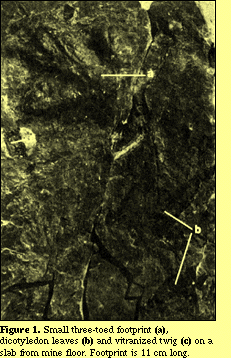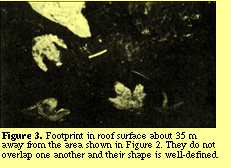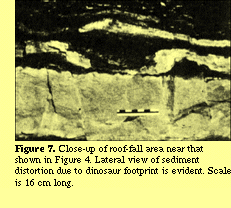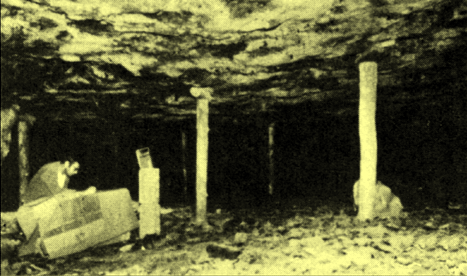Abstract
Dinosaur footprint casts have been observed at three major horizons within coal mines in the Upper Cretaceous (Campanian) Blackhawk Formation near Price, Utah. These include the mine floor, the mine roof, and in sediment above the roof seen only in rock-fall areas. Carbonaceous sandstones in the floor were formed as brackish and subsequently freshwater swamps became established on foreshore sediment, close to the shoreline. A small, bipedal animal producing footprints 11cm long walked in one of these youthful swamps. Sediment exposed in the mine roof, after coal is removed, often has preserved in it thousands of footprint casts of numerous types and sizes of animals which had walked on the peat blanket of much older swamps. In certain areas the soft peat surface had been heavily bioturbated by dinosaur activities with many footprints partly overlapping and obscuring previous tracks. Fossil plants occur with many of these footprints.
Selected coal pillars which support the roof have been removed in some mines, allowing overburden to fall to the floor. These localized rock-fall areas display several levels of fluvial and lacustrine sedimentation some distance above the surface of the coal. It is evident in these units that dinosaurs walked in lake-margin muds, often causing footprint-bioturbation here too. Tail drag features are present in one mudstone. In addition, more than 50 tracks of a large bird which produced footprints 15 cm long occur in a 2 x 2.5 m area of mudstone.
Introduction
This report describes natural casts of dinosaur trace fossils we have observed in coal mines of east-central Utah near the cities of Helper and Price. All mines have been within coals of the Upper Cretaceous (Campanian) Blackhawk formation. We have been able to examine twelve mines within several coal beds and have seen footprint casts in most of them. However, because of certain mining techniques and various factors of preservation, most mines display few specimens of significance. Only four mines have abundant tracks where thousands have been seen (Balsley and Parker 1983, Parker and Rowley 1989, Parker and Balsley in prep.). They are so common in some areas of mine roof that they overlap and obscure one another. In addition to these in Utah, we have been able to study mines in time-equivalent coals near Rock Springs, Wyoming (Rock Springs Formation), and near Cuba, New Mexico (Menefee Formation), where we have seen similar dinosaur traces.
Previous Work
Peterson (1924) first reported natural casts of dinosaur footprints from Rocky Mountain coal mines. He illustrated a track collected in the roof of the now-abandoned Castlegate Mine (Kenilworth Coal, Blackhawk Formation), north of Helper, Utah, and sketched a bipedal trackway in the now-abandoned Ballard Mine (Neslen Coals, Price River Formation) north of Thompson. He also mentioned a collection from the Panther Mine (Castlegate B Coal, Blackhawk Formation), north of Helper. Subsequently, Lull Strevell 1932 sketched a bipedal trackway and described 8 species of "Dinosauropodes" from the now-abandoned Standard Mine (Castlegate A and B Coals, Blackhawk Formation) west of Helper. This collection is housed in the Utah State Natural History Museum, University of Utah, in Salt Lake City (Frank L. DeCourten pers. comm.). A popular account of mine footprints has been written by Wilson (1969). Although Lull's study (Strevell 1932) represented an excellent beginning for studying the biology of the Cretaceous swamp fauna, there were no further studies of dinosaur traces in Utah until we began recording them as part of our examination of the geology, paleontology, and paleoecology of the Blackhawk Formation (Parker 1976, 1979). During field studies we began using the planar surfaces which coal mine roofs and floors provided as a way to extend outcrop exposures of sedimentary features and fossil plants. Dinosaur trace fossils were immediately observed and recognized as an important part of the paleontology of Cretaceous coals (Parker 1980, 1981; Parker and Balsley 1977, in prep.; Balsley and Parker 1983; Parker and Rowley 1989).
Recently, Lockley et al. (1983) and Lockley (1986) have photographed and mapped dinosaur tracks from coal mines of western Colorado. They list previous studies which have mentioned or illustrated dinosaur footprints in mines of east-central Utah and western Colorado. Additionally, Bass et al. (1955) and Ratkevich (1976) have illustrated single footprints from Colorado mines.
Horizons of Preservation
Dinosaur trace fossils occur in three general horizons within coal mines: the floor, deposited with initial stages of swamp development; rock of the immediate roof which was in direct contact with the coal being mined; and in areas where roof-rock has fallen exposing fluvial and lacustrine units as much as 2 m above the coal surface.
 The Mine Floor
The Mine Floor
Occasionally, large thick slabs of coal and rock from mine floors are warped or buckled upward, sometimes violently, because great amounts of energy are directed into the floor from overburden weight by way of coal pillars. Such features are termed mine "bumps" and are of some significance in mine safety (Osterwald and Dunrud 1966). Three small dinosaur tracks were observed on the lower surface of slabs which had been loosened from the floor of a mine in the Kenilworth Coal, near Kenilworth, Utah, east of Helper. These specimens were part of a sequence of left and right footprints made by a single small three toed bipedal animal. One specimen (Fig. 1) was removed from a carbonaceous sandstone slab 2.3 m long, 2 m wide and 25 cm thick. Broad dicotyledon leaves occur on the surface of this rock close to the footprint (Fig. 1). On other slabs, more fossil plants occurred at the same stratigraphic level including fragments of the palm Phoenocities imperialis, plus leafy twigs of the conifers Sequoia cuneata and Moriconea cyclotoxon. About 18 cm below these tracks, leafy twigs of a third conifer, Araucaria sp., are abundant, and the only fossil plant collected at that stratigraphic level.
The Mine Roof
Primary sedimentary features of this mine floor indicate that leafy twigs of Araucaria sp. were deposited on the surface of foreshore or beach sands in brackish mangrove like plant communities, similar to certain extant communities in the Southern Hemisphere where Araucaria sp. is the only woody plant preserved (Balsley and Parker 1983). These swamps developed very close to the shoreline. With seaward progradation of the shoreline, these paralic swamps eventually became less influenced by marine conditions. This allowed several plant communities composed of many ferns, conifers, broadleaved trees, and palms to succeed the Araucaria-dominated community. They became the important peat-producing plants of all the Blackhawk coals (Parker 1976, Balsley and Parker 1983). The animal which made these footprints was walking on a mixture of peat and sand in the young freshwater swamp. Sand in this environment is of the same type as that in the foreshore below. It was apparently blown landward into the swamps or deposited from occasional wash-over fans during storms (Balsley and Parker 1983). The swamp surface here was slightly above sea level and within a short distance, 1 or 2 km, of the shoreline. Footprint casts of this size and type have not been observed elsewhere and may have been produced by an animal which was restricted to paralic delta plane environments.
As coal is mined it usually separates from the roof rock, exposing sedimentary features and various types of fossils which occurred on the immediate surface of the Cretaceous swamps. Roof rock is usually of fluvial origin, deposited into the swamps as overbank sediment when local rivers flooded. Footprints in the peat of the swamp surface were filled with this sediment, preserving a record of the most recent activities of the dinosaur fauna. Such features as bipedal walking patterns, feeding behavior around coalified trees, and resting positions are evident (Parker and Balsley in prep.). Thousands of footprints occur at this coal-roof rock contact. In many mines the roof is so covered by footprints overlapping one another that the entire surface for several hundred square meters is completely bioturbated or "dinoturbated". One such roof surface is within the same Kenilworth Coal mine as the small animal track described from the mine floor.

Here, the roof has a texture of irregular-shaped lumps extending down from the surface as far as 30 cm (Fig. 2). Few distinguishable foot prints can be identified, but innumerable toes, heels and partial footprints overlap one another randomly. In a nearby area, footprints are more separated from one another and distinct in shape and size (Fig. 3). This roof surface has in it at least eight different track types within an area of about 100 m square. It includes one specimen 96 cm in length, the largest we have seen. In another Black hawk mine, 14 track types have been collected from the same kind of roof surface (Parker and Rowley 1989). We recognize the probability that footprints of a single animal species would be preserved differently, depending on animal age, behavior (feeding, progressing, resting), and substratum (kind of peat, kind of clastic sediment). Nevertheless, morphological consistency among numerous specimens (often hundreds of specimens) of a single track type leads us to believe that several animals co-existed in certain swamp forests. Dinosaur traces and their relation to other fossils in mine roof surfaces have been described in more detail (Parker and Balsley 1983, in prep.).

Sediment Above the Mine Roof
In older portions of almost all mines, "room and pillar" methods were used to extract coal. In this process, pillars of coal about 5 m square were left in place to secure the roof. Final mining activities in certain mines included the removal of alternate pillars, eventually allowing sections of the roof to fall. In this way, sedimentary features are exposed as much as 2 m above the coal surface. The significance of these rock-fall areas is that they show depositional and biological activities which occurred after the termination of the peat-forming swamp. Rocks at this level were deposited at the leading edge of the fluvial coastal plain which prograded seaward over the thick peat blanket (Balsley and Parker 1983).
One such mine is west of Helper, Utah in the Castlegate A Coal. In this locality, the coal is covered by thin, laterally extensive, even-bedded lacustrine units, including some with well-defined laminations. Roof falls in this mine (Figs. 4, 5, 8, 12) show sedimentary features in both broad planar and lateral (side) views.
Some beds were heavily bioturbated by several dinosaur types (Fig. 6). Others have no evident tracks at all. One mudstone is covered by large polyhedral cracks indicating fluctuations in water level and subaerial exposure.
Figures 7 and 9 are lateral views of lacustrine beds where distortions of certain units can be seen. Both are vertical sections through dinosaur footprints. The animal which produced the structure in Figure 7 was walking on a peat surface (now the thin coaly layer), its foot pressing into one soft bed below. However, the dinosaur which made the distorted features in Figure 9 was walking on mud.
Occasionally, large, distinctly flat-footed footprint casts occur with a unique straight-sided preservation of the vertical walls. One such specimen is shown in both Figures 10 and 11. It extends down from the surface 28 cm, and is one of three which were in a bipedal trackway. The animal was walking on a thick, soft mud surface and produced a unique "cookie-cutter" effect by apparently placing its feet straight down and lifting them straight up.







